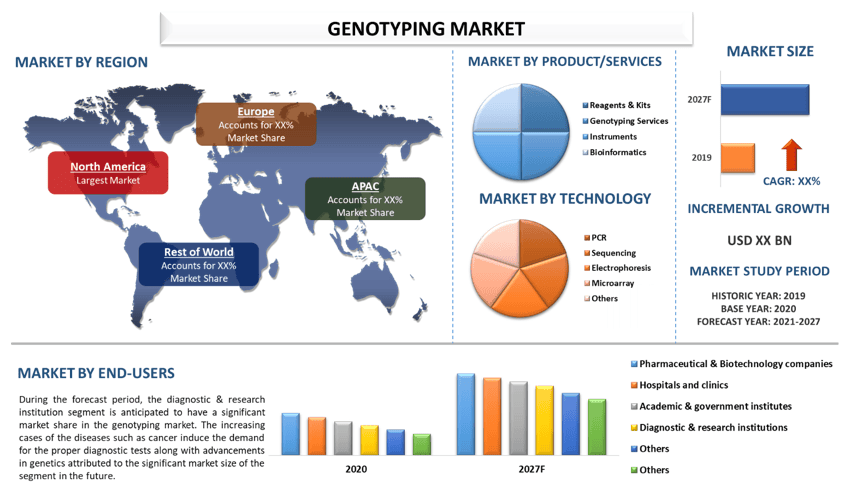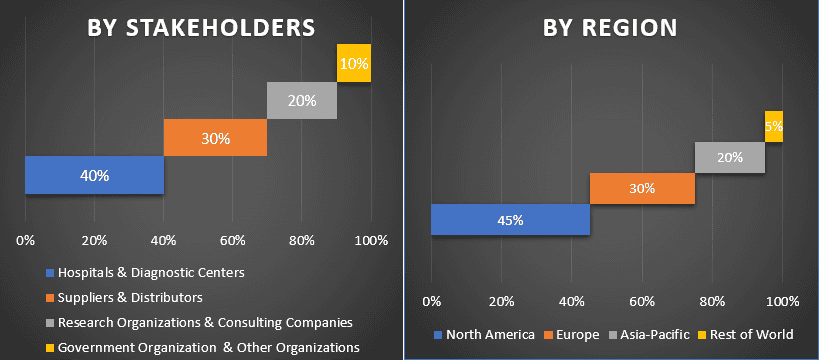- Home
- About Us
- Industry
- Services
- Reading
- Contact Us
Genotyping Market: Current Analysis and Forecast (2021-2027)
Emphasis on Product/Services (Reagents & Kits, Genotyping Services, Instruments, and Bioinformatics.); Technology (PCR, Sequencing, Electrophoresis, Microarray, and Others); End-users (Pharmaceutical & Biotechnology Companies, Hospitals And Clinics, Academic & Government Institutes, Diagnostic & Research Institutions, and Others); Region/Country

Global Genotyping Market is anticipated to grow with an elevated CAGR of around 20% over the forecast period (2021-2027). Genotyping is the process of determining the DNA sequence, called a genotype, at specific positions within the genome of an individual. Sequence variations can be used as markers in linkage and association studies to determine genes relevant to specific traits or diseases.
The genotyping of rare disease help doctors pinpoint the cause of undiagnosed disorders, helping families avoid years of hospital visits and unnecessary tests. These factors are anticipated to boost the market. Furthermore, the increasing prevalence of diseases like cancer along with the surging incidences of rare diseases rises the demand for genotyping diagnostics. According to the ministry of health and welfare of the family, it is estimated that globally around 6000 to 8000 rare diseases exist with new rare diseases being reported in the medical literature regularly. The increasing interest of the global players and the institutions along with the continuous growth of the biotechnology industry also drives the market for genotyping. For instance, As per Invest India, In 2020, the Biotech industry reached a market size of $ 70.2 Bn, rising 12.3% from the previous year. The bioeconomy has observed almost a 95% increase in valuation over the period of five years.
llumina Inc., Thermo Fisher Scientific Inc., Qiagen Inc., F. Hoffmann-La Roche Ltd., Fluidigm Corporation, Danaher Corporation, Agilent Technologies, Eurofins Scientific Inc., GE Healthcare Inc., and Bio-Rad Laboratories Inc, are some of the prominent players operating in the Genotyping market. Several M&As along with partnerships have been undertaken by these players to facilitate customers with new varieties of Genotyping devices.
Insights Presented in the Report
“Amongst Product/Services, Reagents & Kits segment holds the major share”
Based on product/services, the market is fragmented into Reagents & Kits, Genotyping Services, Instruments, and Bioinformatics. The Reagents & Kits segment accounted for a significant market share in 2020 this is mainly due to the increasing investments in R&D and increasing demand for genetic testing drives the market for genotyping industry. However, the bioinformatic segment is expected to witness lucrative growth in the genotyping market owing to the increasing demand for software and the better databases require to store the genetic information. Furthermore, the integration of the devices with the internet and the public network also drives the segmental growth during the forecast period.
“Amongst Technology, sequencing segment is expected to hold the major share”
Based on technology, the market is segmented into PCR, sequencing, electrophoresis, microarray, and others. The PCR segment grabbed a significant market share in 2020. The continuously rising number of incidences of genetic disorders and the deaths raise the growth of the PCR. During the forecast, the sequencing segment is expected to have a considerable market share. This is mainly due to the technological advancement in sequencing technology and frequent product launches by the companies. For instance, in January 2021, Stanford Launched Clinical Whole-Genome Sequencing for Inherited Cardiovascular Testing.
“Amongst end-users, diagnostic & research segment expected to hold the major share”
Based on end-users, the market is fragmented into pharmaceutical & biotechnology companies, hospitals and clinics, academic & government institutes, diagnostic & research institutions, and others. The pharmaceutical & biotechnology companies held a significant market share in 2020. Genomics is enabling pharmaceutical companies to take a more personalized approach to drug development and is expected to result in safer and more effective drugs. However, the diagnostic & research institution segment is predicted to have a significant share in genotyping market in the future. This is mainly due to increasing investment in R&D worldwide along with an increasing number of cases of genetic disorders. For instance, as per UNESCO, Global spending on R&D has reached a record high of almost US$ 1.7 trillion. About 10 countries account for 80% of spending.
“North America represents one of the largest markets of Genotyping market”
For a better understanding of the market dynamics of the Genotyping market, a detailed analysis was conducted for different regions across the globe including North America (U.S, Canada, and the Rest of North America), Europe (Germany, France, Spain, United Kingdom, Italy, and Rest of Europe), Asia-Pacific (China, India, Australia, Japan, and Rest of APAC), Rest of World has been conducted. In 2020, North America dominated the Genotyping industry. This can be mainly due to the presence of well-established market players and frequent product launches along with the presence of government-funded organizations in the region. For instance, The National Human Genome Research Institute (NHGRI) is a part of the National Institutes of Health (NIH) are government organization supported and funded by the U.S government that has a record of the human genome and the genetic disorder.
Reasons to buy this report:
- The study includes market sizing and forecasting analysis validated by authenticated key industry experts
- The report presents a quick review of overall industry performance at one glance
- The report covers an in-depth analysis of prominent industry peers with a primary focus on key business financials, product portfolio, expansion strategies, and recent developments
- Detailed examination of drivers, restraints, key trends, and opportunities prevailing in the industry
- The study comprehensively covers the market across different segments
- Deep dive regional level analysis of the industry
Customization Options:
The global genotyping market can further be customized as per the requirement or any other market segment. Besides this, UMI understands that you may have your own business needs, hence feel free to connect with us to get a report that completely suits your requirements.
Table of Content
Research Methodology for the Global Genotyping Market Analysis (2021-2027)
Analyzing the historical market, estimation of the current market, and forecasting the future market of the global Genotyping market were the three major steps undertaken to create and analyze the adoption of genotyping in major regions globally. Exhaustive secondary research was conducted to collect the historical market numbers and estimate the current market size. Secondly, to validate these insights, numerous findings and assumptions were taken into consideration. Moreover, exhaustive primary interviews were also conducted, with industry experts across the value chain of the global genotyping market. Post assumption and validation of market numbers through primary interviews, we employed a top-down/bottom-up approach to forecasting the complete market size. Thereafter, market breakdown and data triangulation methods were adopted to estimate and analyze the market size of segments and sub-segments the industry pertains to. Detailed methodology is explained below:
Seek More Details About Research Methodology
Analysis of Historical Market Size
Step 1: In-Depth Study of Secondary Sources:
Detail secondary study was conducted to obtain the historical market size of the Genotyping through company internal sources such as annual report & financial statements, performance presentations, press releases, etc., and external sources including journals, news & articles, government publications, competitor publications, sector reports, third-party database, and other credible publications.
Step 2: Market Segmentation:
After obtaining the historical market size of the genotyping market, we conducted a detailed secondary analysis to gather historical market insights and share for different segments & sub-segments for major regions. Major segments included in the report as product/service, end-users, and technology. Further country-level analyses were conducted to evaluate the overall adoption of genotyping across the globe.
Step 3: Factor Analysis:
After acquiring the historical market size of different segments and sub-segments, we conducted a detailed factor analysis to estimate the current market size of the genotyping. Further, we conducted factor analysis using dependent and independent variables such as the growing number of people with chronic diseases and the increasing elderly population all over the globe. A thorough analysis was conducted for demand and supply-side scenarios considering top partnerships, merger and acquisition, business expansion, and product launches in the Genotyping sector across the globe.
Current Market Size Estimate & Forecast
Current Market Sizing: Based on actionable insights from the above 3 steps, we arrived at the current market size, key players in the Genotyping market, and market shares of the segments. All the required percentage shares split, and market breakdowns were determined using the above-mentioned secondary approach and were verified through primary interviews.
Estimation & Forecasting: For market estimation and forecast, weights were assigned to different factors including drivers & trends, restraints, and opportunities available for the stakeholders. After analyzing these factors, relevant forecasting techniques i.e., top-down/bottom-up approach was applied to arrive at the market forecast about 2027 for different segments and subsegments across the major markets globally. The research methodology adopted to estimate the market size encompasses:
- The industry’s market size, in terms of value (US$) and the adoption rate of Genotyping across the major markets domestically
- All percentage shares, splits, and breakdowns of market segments and sub-segments
- Key players in the genotyping market in terms of products offered. Also, the growth strategies adopted by these players to compete in the fast-growing market
Market Size and Share Validation
Primary Research: In-depth interviews were conducted with the Key Opinion Leaders (KOLs) including Top Level Executives (CXO/VPs, Sales Head, Marketing Head, Operational Head, and Regional Head, Country Head, etc.) across major regions. Primary research findings were then summarized, and statistical analysis was performed to prove the stated hypothesis. Inputs from primary research were consolidated with secondary findings, hence turning information into actionable insights.
Split of Primary Participants in Different Regions

Market Engineering
Data triangulation technique was employed to complete the overall market estimation and to arrive at precise statistical numbers of each segment and sub-segment of the genotyping market. Data was split into several segments & sub-segments post studying various parameters and trends in the areas of product/service, end-users, and technology of the genotyping market.
The main objective of the Genotyping Market Study
The current & future market trends of genotyping were pinpointed in the study. Investors can gain strategic insights to base their discretion for investments on the qualitative and quantitative analysis performed in the study. Current and future market trends determined the overall attractiveness of the market at a regional level, providing a platform for the industrial participant to exploit the untapped market to benefit as a first-mover advantage. Other quantitative goals of the studies include:
- Analyze the current and forecast market size of genotyping in terms of value (US$). Also, analyze the current and forecast market size of different segments and sub-segments
- Segments in the study include areas of products/ services and technology.
- Define and analysis of the regulatory framework for the genotyping industry
- Analyze the value chain involved with the presence of various intermediaries, along with analyzing customer and competitor behaviors of the industry
- Analyze the current and forecast market size of the genotyping market for the major region
- Major regions studied in the report include North America, Europe, Asia-Pacific and Rest of the world
- Company profiles of the genotyping market and the growth strategies adopted by the market players to sustain in the fast-growing market
- Deep dive regional level analysis of the industry
Related Reports
Customers who bought this item also bought










